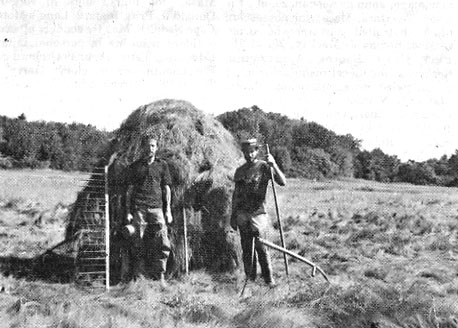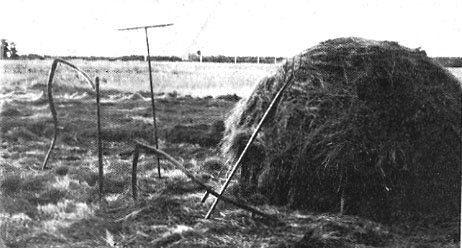By Ed Ballam
Hampton Union, Wednesday, October 3, 1984

(Courtesy photo by Ellen Goethel)
HAMPTON -- Part of the town's history was revived last week with the construction of two haycocks in the marsh behind Tri-Rental on Lafayette Road.
Ellen Goethel, coordinator for the project said the Hampton Conservation Commission constructed the haycocks with money they received from the State Planning office. She said it is part of a marsh awareness program.
"We want people to look out into the marsh and see that it is good for something more than growing greenheads and mosquitoes," Goethel said.
Goethel said many years ago farmers harvested "marsh grass" also known as black grass, to feed it to their livestock. She said the "nutritional value" of the marsh grass is much higher than "regular hay" and it has salt in it, saving the farmer the cost of salt licks and supplements.
She said a haycock is a method of storing the hay used by the farmers before they could transport it to their barns. The haycocks are piles of hay on pieces of wood driven in the ground and stand about two feet in the air. She said all the hay is cut with a scythe and she and Tom Woodard, of Eliot, Maine and a companion, John Mankey, also of Eliot, cut all the hay necessary to build the two haycocks in the marsh.
Goethel explained that every August, the local farmers would go out in the marsh and hay, then place the hay on the pieces of wood called "saddles." Later, the farmers would collect their hay in special boats called "gundalows" (or "gunlows").
"It really has a lot of historic value," Goethel said of the haycocks.
Goethel said the haycocks were constructed in conjunction with Coastal Week to be held Oct. 7 through Oct. 14. She said there will be marsh walks and haying demonstrations in front of the haycocks on Saturday at 12:15 p.m.
"We are trying to get people aware of the value of the marsh," Goethel said.
She said there were special difficulties haying the "cowlicked" matted grass that most farmers don't have to deal with. Conditions have to be just right to hay according to Goethel. The best time to hay it is just after dawn because it cuts best then and the tides have to be low and the weather, good. She said all three conditions have to be met in order to hay the marsh grass.
Gardeners also use the marsh grass for mulch and, in days gone by, people used it for insulation according to Goethel.
She said the Conservation Committee plans to leave the haycocks there and they may even build more. She said the birds have already started using the haycocks to roost on.
"It going to be great for the birds," she said.
The committee made video tapes of the construction of the haycocks and is making them available to schools and "just about anyone who is interested," Goethel said.
She hopes the project will makes people stop and think about the marshes around the area and realize the importance of preserving them.
We have had some really good responses already," she said.
Marsh Haycocks Return
Hampton Union, Wednesday, October 10, 1984

The Hampton Conservation Commission has always kept a close watch over the marshes that surround our town and has done its best to protect them from the encroachments of man. Recently, however, the commission has gone a step farther by "beautifying" the marshland.
The commission has built haycocks on the marshes of the kind seen in the photo above, in bygone days. They serve as a beauty spot, focusing attention into the marsh, and they also revive an ancient tradition.
The salt marsh hay used to have many uses in these parts from livestock feed to garden mulch and insulation. While the marshes around Newbury, Mass., are still hayed actively. Hampton's, and most others, have been disregarded. Consequently, the picturesque haycocks had disappeared from the landscape until this year.
We feel the haycocks perform a function above beautification, however. Some people understand the value of the marshes in maintaining marine life. Beneath that, matted marsh grass, down in the mud and tidal pools, the area teems with life. There, food grows for the fish we catch, and various edible species retire to breed. The marsh is a mass of dead and decaying matter, but it is also the point at which death fuels new life.
For all of this activity, the marshes look particularly quiet and even useless. It is probably because of this that man has never thought twice, until recently, about "reclaiming" marshland by filling it. Filling makes it useful for building, but it has an unseen cost in the tiny creatures who lose ground and the larger animals in the food chain who gradually lose their livelihoods.
This is Coastweek in New Hampshire, a time when we should learn to appreciate what little coast we have by learning about it. The Hampton Conservation Commission's haycocks were built as part of Coastweek, and we think they do help show that the marshes have been, and still are, useful.
In addition, however, the haycocks will be a more permanent reminder that the marshes are both useful and beautiful. Long after the Coastweek tours and speeches are gone, the haycocks will be there. The commission's gift to the town and visitors to the town was welwell considerednd we hope the haycocks will be maintained over the years.
